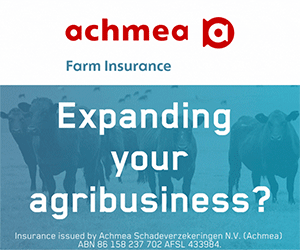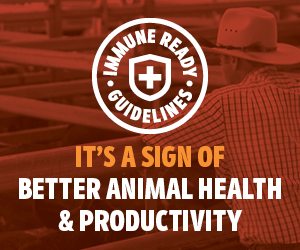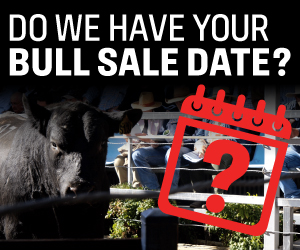Collecting Better Female Fertility Data
Research is now underway to determine whether “better” female fertility EBVs can be calculated by Angus TACE. In particular, whether details from artificial insemination (AI) and embryo transfer (ET) programs could be utilised in the calculation of female fertility EBVs, plus whether additional EBVs to the current Days to Calving EBV should be calculated. Breeders interested in assisting with this research are asked to submit the following female fertility information.
What Female Fertility Information Should be Recorded?
All ‘events’ associated with the joining of their females from the start of the mating period in each breeding season through to when the subsequent calves are born should be recorded.
Broadly, the information to be collected should include:
1. Joining details of all females mated within the herd, including within natural, artificial insemination or embryo transfer programs.
2. Details of all females removed from the herd, particularly those present at joining that were no longer within the herd by the time of the subsequent calving.
3. Details of all calves (dead or alive) that are born as a result of these joinings.
4. Pregnancy test results for all females
Recording Details from Natural Joining Programs
Record each natural joining event to which a female (cow or heifer) is exposed within the breeding season whether this was the successful joining or not. For situations where females are joined to several bulls in a mating season, record all joinings for the female, not just the first or successful joining.
- For each natural joining event within the breeding season, record the bull the female was joined to, the date she was joined (‘bull in’ date) and the date the bull was removed (‘bull out’ date). Knowing the end of the joining period is important.
- The joining event code to be used when recording natural joining events is ‘N’ (Natural/Paddock mating).
Record management group information to identify any cow/s within a joining group whose fertility may have been affected either prior to or during the joining program due to non-genetic factors. e.g. significantly different nutrition, sickness, injury. A maximum of three characters (letters and/or numbers) can be used to describe each management group.
Recording Details from Artificial Insemination Programs
It is important that all ‘events’ associated with the artificial insemination program from the start of the mating period through to when the subsequent calves are born are recorded. This includes details of treatments in addition to the mating itself (eg. synchronisation).
For each female, record the date and ‘type’ of each event within the artificial breeding program using the following event codes:
Z Synchronisation program
M Used to define the mating program period for programs that don’t start with synchronisation. For example, if a mob of cows or heifers enter into a non synchronised mating program that involves artificial insemination followed by a back up bull then ‘M’ would be used to define the date the females initially came together for the program through to the date the back up bull was removed.
A Artificial insemination after a fixed time from synchronisation
I Artificial insemination on observed heat (whether synchronised or not)
N Natural/Paddock Joining (in this case, where females have been joined naturally at the conclusion of an artificial breeding program)
H Hand mating
When recording the date and ‘type’ of each event, note:
The identification of the bull relevant to joining events A, I, N and H needs to be recorded. The event codes M and Z do not need bull details.
Only the joining event codes of M & N require a start and an end date. All other codes (i.e. A, I, H and Z) require only the date to be recorded for the day on which the event occurred.
Record management group information to identify cows that have been managed together as part of the same artificial breeding program. A maximum of three characters (letters and/or numbers) can be used to describe each management group. A management group should also be used to identify any cow/s whose fertility may have been affected either prior to or during the artificial breeding program due to non-genetic factors. e.g. significantly different nutrition, sickness, injury.
Recording Details from Embryo Transfer Programs
- For donor females, record the date the female was flushed and the number of embryos that were collected.
- For recipient females, record the date of implantation for any females that are recorded with Angus Australia. A mating event code of E should be used. It is not necessary to record the details for recipient females that are not recorded with Angus Australia.
Recording Pregnancy Test Results
Where pregnancy test results are available, record the date and result of the test for each female joined.
Pregnancy test results should be reported as:
N = Not pregnant
P = Pregnant
A number between 3-20 (i.e. the number of weeks pregnant as advised by a qualified technician. ) Where the foetus is over 20 weeks old, a ‘P’ should be used.
Recording Calf Details
All calves that are born in the herd need to be recorded with Angus Australia. Not recording all calves (including dead calves) with Angus Australia will compromise the usefulness of the female fertility information.
Record the date and reason for any female removed from the herd, particularly those present at the start of joining that are no longer within the herd by the time of the subsequent calving. The fate/disposal code information is used to determine whether females that have a joining record but no subsequent calf should be penalised for being “culled for infertility” or not penalised because they were culled for other reasons e.g. structure, performance etc. In the future, this information may also be used as part of the calculation of a Female Longevity EBV.
The codes to be used to record a female fate/disposal event are as follows:
Culled or sold
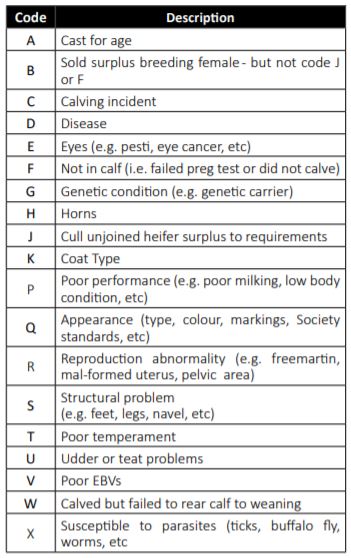
Died or missing
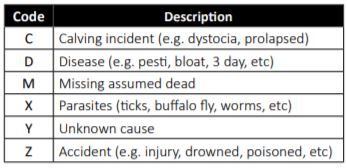
Note: The disposal codes submitted for the purposes of removing animals from the female inventory are not currently linked to the female fertility data that is submitted, and likewise disposal codes submitted for the purposes of research into better female fertility EBVs will not remove animals from the female inventory. Consequently, disposal codes need to be submitted in association with your joining information, even if they have already been submitted with your female inventory.
Joining details recorded for the purposes of research into better female fertility EBVs should be submitted to Angus Australia. Note that the joinings or fate/ disposal information that is submitted as part of your calf registrations or cow inventory will not be included in the research data and/or in the calculation of the current Days to Calving EBVs.
Joining details can be submitted using:
- Members that use a compatible herd recording software package (eg. HerdMASTER, Stockbook, CattleLink) should be able to extract the joining details from their computer program and submit the details to Angus Australia electronically. Members that require assistance either entering the joining details of their herd into their software program or extracting the joinings and fate/ disposal information should contact their software supplier.
- A Microsoft Excel template is available for members not using a compatible herd recording software package. The template can be accessed from the TACE area on the Angus Australia website or by contacting staff at Angus Australia.
Note: There is no paper form available for the submission of female fertility information to Angus Australia. Members that are unable to submit information electronically are advised to contact staff at Angus Australia to discuss alternative methods of submission.
- Joining details for all cows in the recorded herd need to be collected in order to accurately reflect the cow fertility in the herd. Simply recording those cows that have a calf or those cows that remain on inventory in the next year is not adequate.
- Ensure that you record details for all heifers joined – not just the ones that calve or are added to inventory. Information on heifers is very important as many herds cull heifers that do not conceive in the first year of joining. The heifers that do not calve supply as much information to the analysis as those that do calve.
- Record the details of all joining events in which the female was involved even if you know the joining was unsuccessful. For situations where females are joined to several bulls in a mating season, record all joinings for each cow and heifer within the joining period, not just the first or successful joining.
- Accurately recording the fate/disposal codes of all females that leave the herd is extremely important. This fate/disposal code information is used to determine whether a female should be penalised for being “culled for infertility” or not penalised because she was culled for other reasons (eg. structure, performance etc.).
- Joining details for females that have been joined to multiple sire groups (rather than a single sire) should also be recorded. In this scenario, the sire ident that is specified should be the multiple sire ident, rather than the ident of the individual sire that resulted in the calf. Similarly, joining details for females mated to sires not recorded with Angus Australia (e.g. unregistered sires, sires of another breed) should also be submitted.
- Members with either a very wide calving spread (eg. cows joined all year around) or several calvings each year (eg. an autumn, winter and spring calving) may have difficulty collecting good quality female fertility information. Members in such situations should contact staff at Angus Australia for further advice.
Angus Australia acknowledges the funds provided by the Australian Government through the Meat & Livestock Australia Donor Company (MDC).
This resource was created as a result of a collaboration between Angus Australia and Meat & Livestock Australia Donor Company (MDC) (Project P.PSH.1063).


